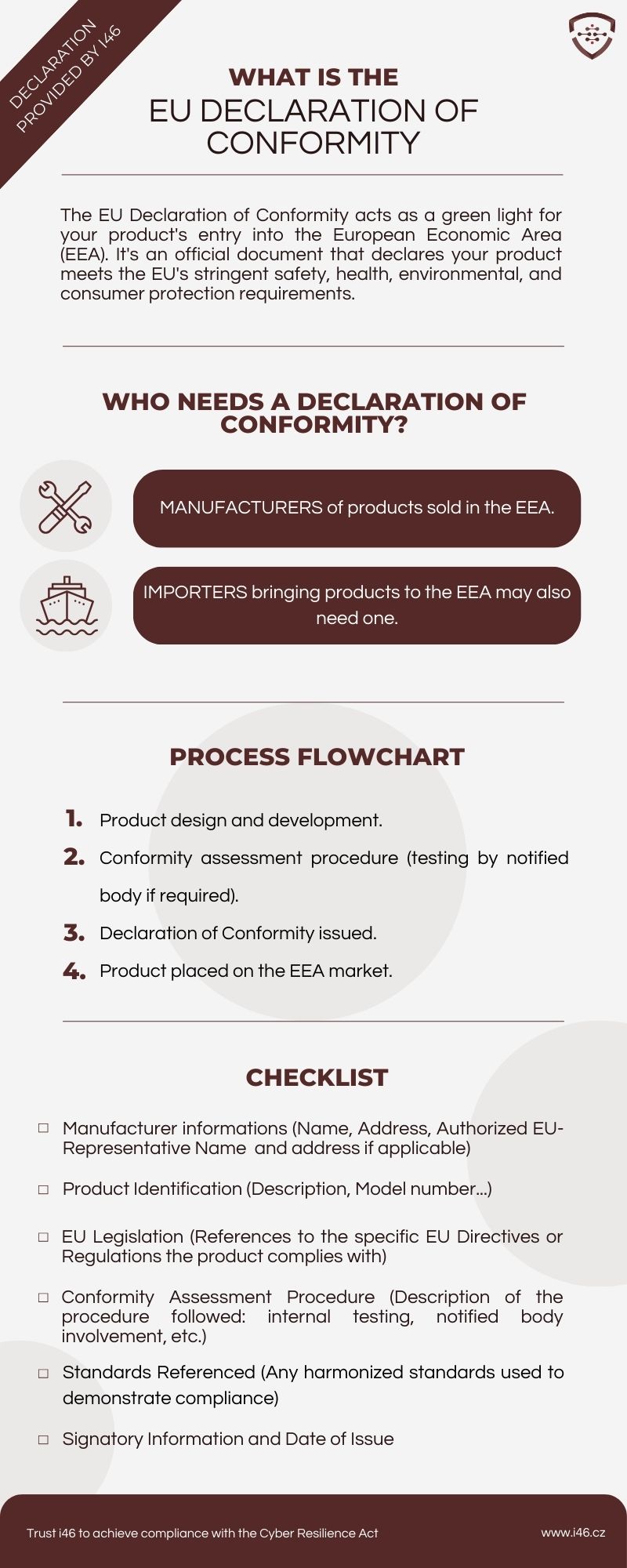The EU Declaration of Conformity: Pillar of the Cyber Resilience Act
The European Union’s Cyber Resilience Act (CRA) stands as a groundbreaking piece of legislation. It establishes the first-ever EU-wide framework for cybersecurity requirements targeting a vast array of products with digital elements. This encompasses a broad spectrum of hardware, software, and any combination of the two that rely on some form of digital functionality. A crucial element of demonstrating compliance with the CRA is the EU Declaration of Conformity (DoC).
Understanding the EU Declaration of Conformity
The EU Declaration of Conformity (DoC) serves as a formal document that a manufacturer creates to declare their product’s adherence to the essential cybersecurity requirements outlined in the CRA. Think of it as a sworn statement attesting to the product’s security posture. This declaration becomes a central piece of documentation that authorities can access for verification purposes.
Content and Structure: A Closer Look
The specific structure and content of the DoC are meticulously outlined in Annex IV of the CRA. Key elements include:
– Product Identification: This section clearly and concisely specifies the exact product covered by the declaration. Ambiguity or confusion regarding the product’s identity can lead to compliance issues down the line.
– Applicable EU Acts: This section meticulously references the relevant sections of the CRA that the product adheres to. Publication references are also included for enhanced clarity and ease of reference.
– Conformity Assessment Procedure: The DoC must explicitly specify the conformity assessment procedure followed by the manufacturer to demonstrate compliance. Different procedures with varying levels of third-party involvement exist, depending on the risk profile of the product. A low-risk product might necessitate a less rigorous procedure compared to a high-risk one.
– Technical Documentation Reference: The DoC references the technical documentation that supports the manufacturer’s claims of compliance. This documentation dives deep into the specifics, detailing the security measures implemented in the product. This technical documentation acts as the backbone for the manufacturer’s assertions regarding the product’s cybersecurity posture.
The DoC: A Dynamic Document, Not a Static Record
The DoC is not a static document gathering dust on a shelf. Article 20 of the CRA mandates that manufacturers continuously update the DoC to reflect any changes made to the product or its security features. This ensures that the declaration remains accurate throughout the product’s lifecycle. Imagine a scenario where a manufacturer releases a software update that addresses a critical vulnerability. The DoC needs to be promptly updated to reflect this change and maintain its credibility.
Accessibility and Transparency: Building Trust Through Information
Transparency is a cornerstone of the CRA. The DoC needs to be readily available in the language(s) required by the member state where the product is placed on the market. This empowers consumers to access information about the product’s security posture and make informed purchasing decisions. Imagine a situation where a consumer is considering purchasing a smart home device. Easy access to the DoC in their native language allows them to understand the device’s security features and make a well-informed choice. Additionally, a copy of the DoC must be provided to relevant authorities upon request, facilitating market surveillance efforts. This empowers authorities to identify potential security risks in products already on the market and take appropriate action if necessary.
The DoC and the CE Marking: Working in Tandem
The familiar CE marking signifies a product’s compliance with relevant EU safety and regulatory requirements. The CRA builds upon this established system. Once a manufacturer has a valid DoC, they can then affix the CE marking to their product, indicating its adherence to the cybersecurity requirements of the CRA. This streamlined approach leverages an existing system while introducing a new layer of focus on cybersecurity.
The Importance of the DoC: A Multifaceted Approach
The DoC plays a pivotal role in achieving the objectives of the CRA. It serves as:
– Proof of Compliance: It demonstrates to authorities and consumers that the product meets the essential cybersecurity requirements established by the CRA. This fosters trust and transparency in the marketplace.
– Manufacturer Accountability: By signing the DoC, the manufacturer takes full responsibility for the product’s cybersecurity throughout its lifecycle. This accountability mechanism incentivizes manufacturers to prioritize robust security measures.
– Market Surveillance Tool: Authorities can utilize the DoC to verify compliance and identify potential security risks in products already on the market. This proactive approach allows for early detection and mitigation of security threats.
The DoC and Conformity Assessment Procedures: Choosing the Right Path
Module A (Internal Production Control)
This is the simplest option, suitable for low-risk products. The manufacturer assumes full responsibility for assessing and declaring conformity. This option is most appropriate for products with a relatively low potential for causing harm if a security vulnerability is exploited.
Modules B + C (EU-Type Examination + Conformity to Type)
These modules involve greater scrutiny by a notified body, an independent organization accredited to perform conformity assessments. The notified body assesses the product’s design and manufacturing processes to ensure they adhere to the CRA’s requirements. This approach offers a more robust level of assurance compared to Module A.
Higher Modules (D1, D2, D3): These cater to high-risk products and involve even more comprehensive assessments by notified bodies. These higher modules might involve penetration testing, vulnerability assessments, and in-depth analysis of the product’s security architecture. This level of scrutiny is essential for products where a security breach could have significant consequences.
The selection of the appropriate conformity assessment procedure depends on several factors, including:
(1) Risk Profile of the Product: The potential impact of a security vulnerability on individuals, businesses, or critical infrastructure plays a crucial role in determining the necessary level of assessment.
(2) Manufacturer’s Experience: Manufacturers with a proven track record of implementing robust security measures might be eligible for less stringent procedures.
(3) Cost and Time Considerations: Higher modules with greater third-party involvement typically carry higher costs and require longer lead times.
Manufacturers should carefully consider these factors when selecting a conformity assessment procedure to ensure they achieve compliance in a way that is both cost-effective and aligns with their product’s risk profile.
The DoC: A Catalyst for a More Secure Digital Landscape
The EU Declaration of Conformity serves as a cornerstone for the Cyber Resilience Act. By requiring manufacturers to declare and continuously update the DoC, the CRA fosters accountability and empowers consumers with valuable information. This transparency fosters trust in the marketplace and incentivizes manufacturers to prioritize security throughout the product lifecycle. As the EU implements the CRA, the DoC will become a familiar sight, signifying a new era of heightened cybersecurity for products within the European market. This, in turn, contributes to a more secure and resilient digital landscape for businesses, consumers, and critical infrastructure alike.
The Road Ahead: Continuous Improvement and Adaptation
The digital landscape is constantly evolving, and new threats emerge regularly. To remain effective, the CRA and the DoC will need to adapt accordingly. Regular reviews and potential revisions will be crucial to ensure the framework continues to address contemporary cybersecurity challenges. Additionally, fostering international cooperation on cybersecurity standards and regulations will further strengthen the collective defense against cyber threats.
The EU Declaration of Conformity represents a significant step forward in securing the digital ecosystem within the European Union. Its success hinges on ongoing collaboration between manufacturers, regulators, and consumers. By working together, stakeholders can leverage the DoC as a powerful tool to build a more secure and resilient digital future.




